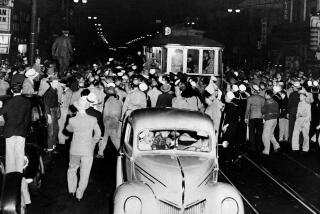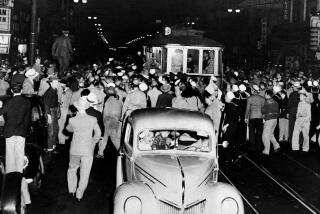Seeking closure
Louis Watson, Dwight Taylor and Gregory Davis Jr. were the first casualties of the L.A. riots, mortally wounded in a volley of gunfire early on the evening of April 29, 1992.
Over the last 20 years, police detectives and family members have tried to imagine what exactly happened near Vernon and Vermont avenues. They know it was a chaotic moment. Police believe all three were innocent victims, but they were surrounded by a mob looting a large swap meet at the corner.
For The Record
Los Angeles Times Saturday, May 05, 2012 Home Edition Main News Part A Page 4 News Desk 1 inches; 47 words Type of Material: Correction
Unsolved riot homicides: In some copies of the May 3 Section A, a map accompanying an article about unsolved homicides that occurred during the 1992 riots placed Los Angeles International Airport slightly south of its actual location. A corrected version of the map is online at www.latimes.com/riotunsolvedmap.
![]()
They can replay so much of the scene -- but not who pulled the trigger. Was it a gang member shooting randomly into a crowd? Was it somehow related to the looting going around them? Or did the gunman purposely target them?
Watson, Taylor and Davis were among 36 victims of riot-related homicides. Of those cases, 23 remain unsolved. But the deaths of the three are the only case the Los Angeles Police Department is still actively investigating.
In the months after the riots, police detectives told reporters they were optimistic about solving the cases. They talked of suspects and possible motives. But over time, all the trails went cold. They interviewed and re-interviewed witnesses. At one point, they closed in on someone they believed was a suspect, only to pull back and then develop a whole new theory about what happened.
In the beginning, family members eagerly awaited updates from detectives, and some even investigated on their own. But over time, they moved on.
Myiesha Taylor was a high school senior when her father, Dwight, a 42-year-old former Cal State Long Beach basketball star, was killed. She went to college at Xavier University in New Orleans thinking police had identified the gunman and that an arrest might be imminent. Now an emergency room doctor living in the Dallas area, she wonders if they will ever know who killed her father.
“I think the city owes it to the families to solve my father’s killing and the killings of all those who lost their lives,” she said.
Making connections
At first, there was little to connect the shootings. All three victims were rushed to different hospitals.
It took several days for detectives to determine they were shot at the same place and time. The case began getting media attention after the L.A. County coroner’s office declared that Watson, 18, was the first person killed during the riots. His family said at the time that he was helping an elderly woman get on a bus just before the gunfire rang out.
At his funeral a few days later, some of his friends stormed out in the middle of the service, vowing revenge on whoever killed him. “Show Louis your respect,” the pastor urged them, The Times reported. “If there is anybody here who feels like retaliating, forget it.”
Detectives quickly concluded that Watson, Taylor and Davis, 15, had no connections and just happened to be at the wrong place at the wrong time. Taylor worked at a fish market in the area in a job that earned him the nickname “The Fishman” in the neighborhood. His family said Taylor was walking to get some milk and other groceries when he was gunned down.
Davis was a high school athlete who was at the intersection with his father.
In 1992, Los Angeles recorded the most homicides in its history -- 1,096 -- and detectives were working multiple cases in the months after the riots.
Detectives at the time praised Watson’s father, Eric Fleming, for launching his own investigation and providing what they described as “crucial” evidence. A few days after the killings, Fleming surveyed the swap meet parking lot and found his son’s bloody cap on the ground.
Some witnesses said they believed the bullet that hit Watson in the head bounced off a safe being hauled out by some looters.
By June, police said the leading theory was that the gunman was a gang member who had targeted Watson, and that Taylor and Davis were collateral damage.
Myiesha Taylor said detectives told her family that a woman had called police and said her son or his friend was bragging about a shooting.
“I assumed they had the guy,” she said. “They had the idea it was a gang initiation.”
But then the case began to drag on. No arrests were made. And for reasons that are unclear, detectives backed away from their original theory.
“The person who was the focus of the investigation didn’t pan out,” said Det. Rick Gordon.
The dead end frustrated Taylor as well as Gregory Davis’ mother, Wanda Harris.
Harris and her son’s father also stayed in touch with detectives and believed an arrest would come. She sued the city of Los Angeles, but the suit fizzled.
They eventually moved from South L.A. to Palmdale. And a few years ago, she buried Gregory’s father in a grave next to her son.
Harris often wonders what the killer must be thinking about what he did. But she’s come to peace with the idea that she might never know who that is.
“I am just not sure how they will ever identify anyone,” she said. “It’s a long, long time ago.”
Taking a new look
The case lay dormant until early this year.
Then one day, David Garrido, homicide supervisor in the Southwest division, was thumbing through some unsolved “murder books” when he came upon the triple homicide near Vernon and Vermont.
“It just stood out to me, and I began to read the book,” he said. “It looked like it was a workable case -- something we could try to do something with.”
He assigned it to Det. Robert Lait. He has interviewed some people who knew Louis Watson back then and also talked to the original detective who worked the case.
But after several months of work, the LAPD doesn’t have a suspect or a motive.
“It looks like someone shot into the crowd,” Lait said. He believes it was a single gunman but isn’t sure whether one of the victims was targeted or if it was all random. Investigators have not revealed any ballistics evidence, including whether just one weapon was used.
Officials admit that they have a long way to go but vow to keep investigating.
“It is now back to where it was in the first place,” Det. Gordon said. “A whodunit, so to speak.”
Myiesha Taylor is still holding out hope that police will find the killer, and in the process help her family -- and the rest of the world -- understand exactly how her father died.
“You had the idea those getting shot were doing things they shouldn’t or were some place they shouldn’t be,” she said. “Then you learn your father died going to get some milk.”
Detectives ask that anyone with information related to the killings contact Gordon at (213) 485-4341.
--
richard.winton@latimes.com
maloy.moore@latimes.com
andrew.blankstein@latimes.com
More to Read
Start your day right
Sign up for Essential California for news, features and recommendations from the L.A. Times and beyond in your inbox six days a week.
You may occasionally receive promotional content from the Los Angeles Times.








